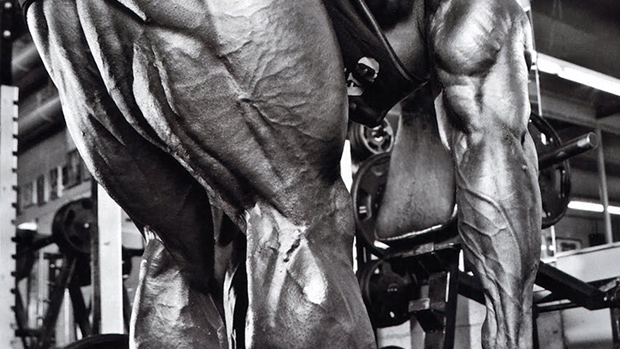A lot of top athletes use kinesiology or kinesio tape. Many of them even have endorsement deals with the various makers of the tape. Yes, these folks are incredible athletes, but that doesn't mean the tape is contributing to their abilities. Or does it?
You've probably seen everyone from Olympic athletes to CrossFitters using K-tape on just about every part of their bodies: quads, hamstrings, calves, low back, shoulders, etc. It doesn't look like it's doing anything other than just sitting on their skin. So I decided to do some research to try and uncover any scientific backing for the product.
While there are tons of studies involving using the tape for seemingly everything under the sun, we're going to focus on just a few that pertain more to athletes and the reasons most athletes use it: performance, stability/proprioception, and pain management.
The word "performance" can be broad, but in this case we're referring to anything that has to do with strength, power, muscle activation, or some sort of outcome variable related to muscle function. Here are a few summaries of the findings in studies relating to performance:
- Lee NH et al. taped the knee and quad and found no difference in their measures for anaerobic power, muscular strength, and self-perceived fatigue between no-tape, athletic tape, and kinesio tape in the quads. They did find a significant difference in muscular endurance between treatments, but performance was best in the no-tape trial compared to kinesio tape and athletic tape. The subjects in this study were overweight college students though, so the ability to extrapolate results to an athletic population is hard to determine.
- MacPhail AJC et al. took people who used kinesio tape regularly and those who didn't, and tested grip strength of both groups under a tape and no-tape protocol. The tape protocol was supposed to decrease muscle activity. It didn't. No differences in EMG or grip strength were seen between trials in either population of kinesio tape wearers or non-wearers.
- Poon KY et al. were able to blind participants to a possible placebo effect of using the tape by only including people who had never heard of kinesio tape. They taped around the knee and quad in a way that was supposed to increase muscle activation. However, there were no differences in torque, time to peak torque, or total work done during their leg extension tests in a taped, kinesio taped, and no-tape trial. Once again we see no real benefit.
- Keenan KH et al. compared taping the shoulder using people with healthy shoulders and those with shoulder impingements. The tape didn't provide any alterations in scapula movement or internal or external rotational strength in the shoulder. Unfortunately they didn't assess pain level, and since shoulder impingements were involved that would have been helpful. Either way, if pain was present, it didn't seem to affect any performance measures.
- As the final blast to the notion that kinesio tape helps performance, a giant systematic review and meta-analysis including 53 studies that dealt with tape and various performance measures by Reneker JC et al. concluded, "There is a lack of compelling evidence to support the use of KT to enhance the sports performance abilities based on this review."
For performance, the evidence doesn't seem to be there.

- In a test of ankle stability by Doyel K et al., kinesio tape helped just as much as athletic tape or another generic tape. It seems just having anything there for support helps without the need specifically for fancy kinesio tape. General athletic tape can provide support as well as kinesio tape.
- Torres R et al. looked at the effect of kinesio tape on joint position and ability to detect passive movement. While ability to remember joint position wasn't different between the taped and untaped group, the ability to detect passive movement was different.
- But the ability to recognize passive limb movement has little transfer to sport performance. Why? Because most sports involve active movement. Also, various clothing has the ability to help influence proprioception and joint position (like compression gear and knee sleeves). Once again it seems kinesio tape falls short.
This is where it seems kinesio tape may have benefit.
- Aghapour E et al. found that pain was reduced and increased torque was observed in the quad following taping of the vastus medialis. This was in a population of athletes with knee pain.
- Looking at a population of athletes with lower back pain, Kamali F et al. tested whether spinal manipulation coupled with KT decreased pain to a greater degree than just spinal manipulation alone. Result? There was no significant differences between the treatments, although slightly lower values were seen for pain and in the disability index in the spinal manipulation and kinesio tape treatment group. Although not significant, lower levels of pain are lower levels of pain.

The only real merit for kinesio tape seems to be in an injury or situation that involves pain of some type.
If there's a problem involving pain, kinesio tape may help the alleviate symptoms and be a tool in the recovery or healing/fixing process, but it shouldn't be the only intervention used. If there's a problem, issue, or pain with a joint, tendon, muscle etc. corrective action should be put into place and proper guidance of an exercise professional, athletic trainer, or physical therapist should be sought after.
Since proper anatomical placement and stretch of the tape are of utmost importance, it should be applied by a professional too. As others have concluded here on T Nation, most people can't put the tape on effectively unless they've been formally trained to do it.
For anyone healthy and without pain, the use of kinesio tape is irrelevant, and the claims for performance enhancement simply aren't backed up by science.
- Lee NH et al. Acute effects of kinesio taping on muscle function and self-perceived fatigue level in healthy adults. Eur J Sport Sci. 2017 Jul;17(6):757-764. PubMed.
- Keenan KH et al. Kinesiology taping does not alter shoulder strength, shoulder proprioception, or scapular kinematics in healthy, physically active subjects and subjects with subacromial impingement syndrome. Phys Ther Sport. 2017 Mar;24:60-66. PubMed.
- Reneker JC et al. Effectiveness of kinesiology tape on sports performance abilities in athletes: A systematic review. Phys Ther Sport. 2018 May;31:83-98. PubMed.
- MacPhail AJC et al. Type effect of inhibitory KT tape on measured vs. perceived maximal grip strength. J Bodyw Mov Ther. 2018 Jul;22(3):639-642. PubMed.
- Poon KY et al. Kinesiology tape does not facilitate muscle performance: A deceptive controlled trial. Man Ther. 2015 Feb;20(1):130-3. PubMed.
- Doyel K et al. The effects of KT taping on ankle stability. Research Quarterly for Exercise and Sport. 2014;85(S1):18.
- Torres R et al. The effect of kinesiology tape on knee proprioception in healthy subjects. J Bodyw Mov Ther. 2016 Oct;20(4):857-862. PubMed.
- Aghapour E et al. Effects of kinesio taping® on knee function and pain in athletes with patellofemoral pain syndrome. J Bodyw Mov Ther. 2017 Oct;21(4):835-839. PubMed.
- Kamali F et al. Comparing spinal manipulation with and without Kinesio Taping in the treatment of chronic low back pain. J Bodyw Mov Ther. 2018 Apr;22(2):540-545. PubMed.




